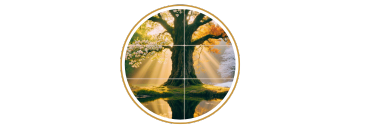任脈 (Rèn Mài) — The Conception Vessel
任 (Rèn): The character 任 signifies "to bear, to carry responsibility, to entrust." It combines the person radical (亻) with the phonetic 壬, symbolizing the body's duty to nourish and sustain. In the Conception Vessel, it evokes the profound task of carrying life, whether in the womb, in the blood, or in the hidden spark of ideas yet to be born.
脈 (Mài): The character 脈 means "vessel, meridian, pulse." It combines 月 (flesh) with 永 (eternal flow), representing circulation that never ceases, the endless river of life within us.
Together — 任脈 (Rèn Mài): The Conception Vessel is called the "Sea of Yin," the channel that governs fertility, creation, and nourishment. More than a pathway, it is a living metaphor for the body's capacity to hold, sustain, and bring forth new beginnings.
Spiritual Symbolism: The Ren Mai embodies Yin — receptive, grounding, life-giving. It stabilizes Yang by containing it and is most influential in reproduction and childbirth. It is the vessel of beginnings, carrying the possibility of renewal in every cycle.
CV4 Guanyuan — 關元 (Gate of Origin)
Name & Imagery
CV4, Guanyuan — "Gate of Origin," stands as a luminous anchor of vitality on the Conception Vessel. This point evokes a sacred reservoir where Yin essence gathers and nourishes life. Often regarded as the body's energetic “wellspring,” Guanyuan is both a stabilizer and a source of creation, linking the lower abdomen to the depth of generative power.
Location
CV4 is located on the anterior midline of the lower abdomen, 3 cun below the umbilicus, and approximately 2 cun above the pubic symphysis. This placement situates it at the intersection of the body's energy and its creative potential, marking the threshold where essence consolidates and life force is fortified.
Classical Functions
In classical Chinese medicine, CV4 is prized for its role in strengthening Kidney and reproductive functions. It is used to tonify Qi and Yin, support fertility, regulate menstruation, alleviate urinary disorders, and enhance overall vitality. Daoist physicians referred to it as the "Origin of Vitality," a point to preserve essence, nourish life, and prolong longevity.
Modern Context
Today, CV4 is widely applied in acupuncture, moxibustion, and gentle acupressure to support reproductive health, improve pelvic floor function, and boost vitality. Its influence extends to both male and female reproductive systems and is considered a central point for holistic wellness, emotional grounding, and energetic balance.
Symbolism and Cross-Cultural Echoes
CV4 corresponds to the Svadhisthana (sacral) chakra in Indian traditions, emphasizing creativity, sexuality, and vitality. Both systems recognize the area as a core reservoir of life energy. Daoist texts depict CV4 as a hidden well or treasure, a sacred container of Yin essence whose careful preservation sustains longevity and vigor.
Point Combinations
CV4 is often paired with CV6 (Qihai) to strengthen Qi and consolidate the body’s lower energy. It may also be combined with CV3 (Zhongji) to regulate the lower jiao and reproductive organs, or with BL23 (Shenshu) to nourish the Kidneys, creating a network of points that harmonizes root and source.
Gentle Practice for Self-Care
To honor CV4, one can sit quietly with the breath sinking into the lower abdomen, visualizing the accumulation and circulation of life force. Gentle abdominal massage, moxibustion, or mindful pelvic awareness helps awaken grounding, vitality, and creative energy. Daily attention to this center nurtures both body and spirit.
Reflection
What sources of vitality do I carry within me, and how can I nurture them with care? Where in my life do I need to protect, replenish, and allow creation to flow freely?
References
GB/T 12346-2021. Nomenclature and Location of Acupoints. Standardization Administration of China.
Huangdi Neijing (Yellow Emperor’s Inner Classic). c. 2nd century BCE.
Wiseman, N., & Ellis, A. Fundamentals of Chinese Medicine. Paradigm Publications, 1995.
Kaptchuk, T. J. The Web That Has No Weaver: Understanding Chinese Medicine. McGraw-Hill, 2000.
Panagiota Sophia Vlahou
Certified Beekeeper | Specializing in Traditional Beekeeping & Natural Wellness Methods
Trained in Traditional Acupuncture – Academy of Traditional & Chinese Medicine
Member of the Beekeepers’ Association of Attica-Greece
Disclaimer: This article is for educational and informational purposes only. It is not intended to diagnose, treat, cure, or prevent any disease, and it does not substitute professional medical advice. Always consult a qualified healthcare professional before making any changes to your diet, lifestyle, or health practices.

